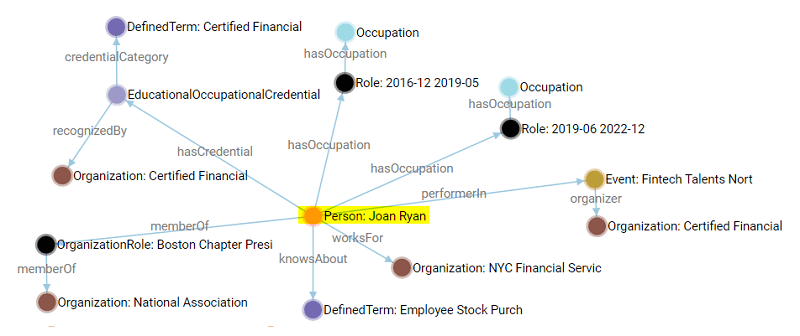The ❝Person❞ schema markup is useful for authors, bloggers and all those who have their personal websites or portfolios. You can add the person schema markup to make sure all your necessary information is displayed when someone searches for you through search engines.
While it’s useful, some properties/attributes for the ❝Person❞ schema markup are often underused, but they can be very helpful in boosting E-E-A-T (Experience, Expertise, Authoritativeness, Trustworthiness). They’re: ❝hasCredential❞, ❝hasOccupation❞ and ❝performerIn❞. Grab the free source code now to see how they can be linked to the ❝Person❞ schema markup to form a better knowledge graph.
1. ❝hasCredential❞: It describes a person’s qualifications or achievements, e.g. CPA, CFP and CEP. To mark it up for a person, you can do it this way: Person➤ HasCredential➤ EducationalOccupationalCredential➤ credentialCategory➤ recognizedBy➤ Organization
"hasCredential": {
"@type": "EducationalOccupationalCredential",
"credentialCategory": {
"@type": "DefinedTerm",
"name": "Certified Financial Planner",
"termCode": "CFP"
},
"recognizedBy": {
"@type": "Organization",
"name": "Certified Financial Planner Board",
"alternateName": "CFP Board",
"url": "https://www.cfp.net/"
}
},2. ❝hasOccupation❞: It’s an appropriate property to indicate the past professions of a person. You can do it this way: Person➤ hasOccupation➤ Role➤ skills, start/endDate
"hasOccupation": [
{
"@type": "Role",
"hasOccupation": {
"@type": "Occupation",
"Name": "Senior financial advisor",
"skills": "Executive wealth planning, Wealth management, Financial data analysis, Interpersonal communication"
},
"startDate": "2019-06",
"endDate": "2022-12"
},{
"@type": "Role",
"hasOccupation": {
"@type": "Occupation",
"Name": "Financial planner",
"skills": "Wealth management, Investment Strategies, Interpersonal communication"
},
"startDate": "2016-12",
"endDate": "2019-05"
}
],3. ❝performerIn❞: It’s a good idea to specify the industry events that a person is a presenter or performer in. You can do so like: Person➤ performerIn➤ Event➤ Organizer
"performerIn":
{
"@type": "Event",
"name": "Fintech Talents North America 2023",
"url": "https://www.fintechtalents.com/events/north-america/",
"startDate": "2023-06-12",
"endDate": "2023-06-14",
"description": "Joan Ryan is one of the presenters at Fintech Talents North America 2023 where brings financial
professionals from a wide range of organizations and global tech providers together to exchange experiences and ideas on
industry trends.",
"about": "Fintech Wellness",
"location": "New York City, United States",
"organizer": {
"@type": "Organization",
"name": "Certified Financial Planner Board",
"alternateName": "CFP Board",
"url": "https://www.cfp.net/"
}
},As you can see, we can link so many entities to a person with varied attributes but we need to draw a line. In my opinion, we should focus on relevancy and mark up the things that matter to boost a website’s E-E-A-T instead of everything about a person. Sticking to the same example, Joan’s early work experience as a photographer isn’t highly relevant to a financial firm’s website so in this case this information wasn’t marked up.
Although I only highlighted three properties for the ❝Person❞ schema above, don’t forget other important ones. Some of them include ❝worksFor❞, ❝memberOf❞, ❝knowsAbout❞ and ❝sameAs❞.
Gathering all relevant information available allows for better knowledge graph integration and boosting our SEO game. We can finally link them together to see the beginnings of this ❝Person❞ knowledge graph. Feel free to grab the free source code here.
